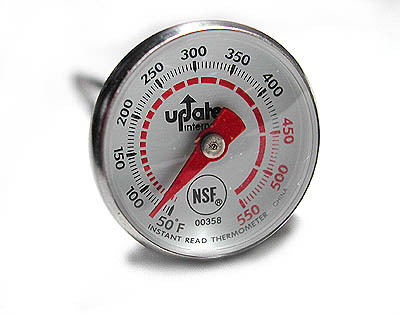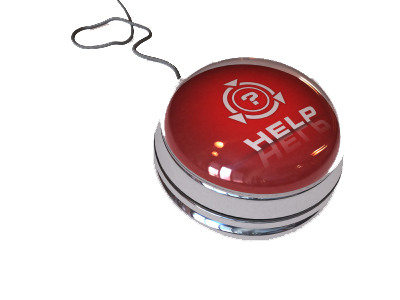
GC troubleshooting
Cleaning the injector
INJECTOR
- It is reported that the cause of 85-90% of problems during analysis can be found in the inlet. Therefore, do not forget to regularly replace all consumables. The liner, septum and all seals have a limited lifespan!
- Sometimes, however, replacing consumables or cutting the column is not enough. Then it is necessary to clean the supply. General instructions can be found below, but always follow your manufacturer's instructions first and foremost!
Cleaning
- Cool the inlet. The temperature should not exceed 40°C.
- Turn off the carrier gas flow.
- Uninstall any autosampler.
- Uninstall the column.
- Open the inlet, remove all consumables.
- If possible, it is preferable to disconnect the split branch of the pneumatic system from the inlet.
- The inlet now consists of just a metal tube, which may or may not be tapered at the end.
- There are various tools that can be used for cleaning (eg a grater). Using such a brush and methylene chloride and methanol, move down and clean the intake.
- Using a pipette, spray the inlet with solvent (capture the solvent under the inlet in a beaker) and make sure that no dirt particles remain in the inlet.
- To remove residues, insert and heat the inlet to approx. 65 °C.
- Reinstall the split branch of the pneumatic system, install new consumables.
- Turn on the carrier gas flow. Check for leaks.
- Allow the supply to flush for at least 10 minutes before increasing the temperature. Remove residual oxygen. A premature increase in temperature may activate and degrade the new consumable.
Cleaning the detector
FID
Audible noise, random ghost peaks, low sensitivity. These are typical characteristics of dirty FID detector.
The most common cause contamination sulfide is bleeding from the column. Burned stationary phase may be deposited on the nozzle surface of the detector and cause problems. However, the nozzle napalují and other contaminants.
You need to clean your detector?
The above-described problems, however, may not only be caused by contamination of the detector. The steps outlined below will help rule out other potential causes.
The carrier gas and the stationary phase bleeding
Possible source of contamination can be found not only in the detector itself, but also in front of him. Bleeding stationary phase column, septum, inlet contaminated, contaminated carrier gas ... To eliminate this source Blind FIDU corresponding input plug and turn the FID. If the problem ceases, search problem outside detector. No need to replace the liner? Septum? Clean inlet? What is the state column? Do you have a pure carrier gas? You do not have a leak in the system?
Hydrogen and air
Even hydrogen and air used in the sulfide can be a source of contamination. Attention: especially when problems emerged after replacing the cylinder.
Also improper flow / pressure of the two gases can be a source of increased noise and reduced sensitivity to ignition problems sulfide. Make flows through the meter.
Electrical System
I electrical interference may exhibit similar symptoms dirty FID. There may be a defect electrometer, poor contact or interference by other devices in the lab.
Before cleaning
- Make sure to unplug the power cord!
- Remember that the detector may be hot!
- When dismantling FIDU pay attention insulating parts. Use tweezers, whether these parts do not transfer dirt from your hands or gloves. Beware of possible scratches.
- Remember that sometimes it may be easier to change the nozzle before it is cleaned. This is particularly true when the nozzle is heavily contaminated and sharply increases the risk of scratches during nozzle cleaning.
Cleaning
- Remove the nozzle from the sulfide.
- Place it in an ultrasonic bath with water and detergent and ultrazvukujte about 5-10min.
- Use a tool or a suitable thin wire purge nozzle. Be careful. Any scratches may change the shape of the flame, increasing noise or loss of sensitivity.
- Re-insert the nozzle into the ultrasonic bath and ultrazvukujte other 5-10min. From now handling the nozzle use only tweezers.
- Rinse the nozzle with clean water.
- Rinse nozzle small amount of methanol.
- Blow nozzle stream of air or nitrogen.
- Let dry nozzle.
- Seskládejte FID. Pay attention to tightening. When you drag nozzle may cause its deformation!
- After seskládání can connect column. It is appropriate to heat the FID temperature 10 ° C-40 ° C higher than the normal operating temperature of the detector. Note maximum temperature limit FIDU! Note the maximum operating temperature of the column!
How to keep your detector FIT
- A new column is bleeding most. Install the column and into the inlet, as usual, but let the detector end freely in the furnace and condition the column. Then install the column and into the detector.
- Use a good quality, low column bleed.
- Moisture and oxygen in the carrier gas deplete the stationary phase of the column and cause a bleeding. Wear high-purity gases, molecular sieves, traps ... Check the tightness of the gas circuit.
- Use appropriate septa with low bleed and change them often enough.
ECD
ECD is a specific and sensitive detector. Inappropriate behavior, however, can sharply reduce its lifespan. The gradual increase in signal at this detector normal. However, if an increase occurs abruptly or adding more of the symptoms worsening-noise desensitization search problem.
Cleaning
- ECD contains radioactive material, therefore, mandated regular wear tests. It is forbidden to open or to interfere in any way.
- ECD can be cleaned only thermally. Generally, cleaning is performed so that the ECD detector heated to a temperature close to its maximum operating temperature and impurities are burned. Before cleaning, be sure there are no leaks. Raising the temperature takes place gradually. Track signal. Increase the temperature by 10-20 ° C, the signal starts to grow. Wait for the signal to stabilize and begin to decline, then you can again increase the temperature. Upon reaching the desired temperature, wait for the signal to decrease the expected values.
- Follow the instructions of your manufacturer, the procedure may vary.
- If you heat detector installed column exceed the maximum operating temperature of the column or column Deinstall detector and replace the plug.
Do not ruin your detector!
- Use good quality gas intended for ECD.
- Use molecular sieves, traps for purification of gases.
- When potížích- increase in signal noise worse, desensitizing like. Check system for leaks.
- Use quality columns and septa with low bleeding.
GC troubleshooting
Prevention
Many GC problems can be prevented if the column is properly installed and GC is maintained routinely. For example, replacing septa or liner at regular intervals and keeping the injector and detector clean and well-maintained shoud solve many problems. Regular preventive maintenance depends on particular model of GC and you should consult required operations in the operator's and service manuals.
For the problem identification we recommend to use electronic flowmeter and leak detector.
Baseline problems
 Baseline problems could be divided into 5 categories: drift, noise, offset, spiking and wander.
Baseline problems could be divided into 5 categories: drift, noise, offset, spiking and wander.
- Drift means slow baseline movement in one direction
- Noise is rapid and random movement of the baseline position
- Offset is sudden unexplained change of the baseline position
- Spiking is presented by peaks with no width, either positive or negative
- Wander is low frequency noise
Downward drift
| Possible cause | Suggestions |
|---|---|
| Downward drift for a few minutes is normal after installing a new column | Increase the oven temperature to close to the maximum continuous operating temperature for the column. Maintain the temperature until flat baseline is observed. If the detector signal does not drop in 10 minutes, immediately cool the column and check for leaks. |
| Unequilibrated detector | Allow sufficient time for temperature equilibration of the detector. |
| Downward drift is frequently due to the "back-out" of contaminants from the detector or other parts of the GC | Clean out contamination. |
Upward drift
| Possible cause | Suggestions |
|---|---|
| Damage to the stationary phase of the GC column | Determine the cause of the damage. It may be due to impurities in the carrier gas or to excessive temperatures. Replace column. |
| Drift in gas flow rates | Clean or replace flow or pressure regulator(s). Adjust pressure. |
Noise
| Possible cause | Suggestions |
|---|---|
| The column may be inserted too far into the flame of an FID, NPD or FPD detector | Reinstall the column. Be sure to insert the column into the detector exactly the correct distance specified in the instrument manual. |
| An air leak can result in noise in ECD and TCD detectors | Eliminate the leak. |
| Incorrect combustion gases or flow rates can generate nois in FID, NPD or FPD detectors. | Be sure yuor gases are the proper grade, as well as clean and dry. Reset the flow rates of the gases to their proper values. |
| Contaminated injector | Clean injector. Replace inlet liner, septa and selas. |
| Contaminated column | Bake out the column. Cut off first 10 cm of column. If it does not help, replace the column. |
| Defective detector | Clean and/or replace parts as necessary. |
| Defective detector board | Consult GC manufacturer. |
Offset
| Possible cause | Suggestions |
|---|---|
| Line voltage changes | Monitor line voltage for correlation with offset. If correlation is found, install voltage regulator or ensure stable power supply. |
| Poor electrical changes | Check electrical connections. Tighten any loose connections. Clean any dirty or corroded connections. |
| Contaminated injector | Clean injector. Replace inlet liner, septa and selas. |
| Contaminated column | Bake out the column. Cut off first 10 cm of column. If it does not help, replace the column. |
| Column inserted too fat into the flame of FID, NPD or FPD detectors | Reinstall the column. Be sure to insert the column into the detector exactly the correct distance specified in the instrument manual. |
| Contaminated detector | Clean the detector if possible. |
Spiking
| Possible cause | Suggestions |
|---|---|
| Electrical disturbances entering the chromatograph through power cables, even shielded cables | Try to correlate spikes with events in equipment near the chromatograph. Periodicity is often a clue. Turn off equipment or move it. If necessary, install a voltage regulator. |
Wander
| Possible cause | Suggestions |
|---|---|
| Baseline wandering may be caused by changes in environmental conditions such as temperature or line voltage | Try to correlate the wandering with environmental parameters. If a correlation is observed, you will know what to do. |
| Inadequate temperature control Check if variations can be correlated with changes in the baseline position. | Measure detector temperature. |
| Wandering while using isothermal conditions may be due to contaminated carrier gas | Change the carrier gas or the gas purification traps. |
| Contaminated injector | Clean injector. Replace inlet liner, glass wool and seals. |
| Contaminated column | Bake out the column. Cut off first 10 cm of column. If it does not help, replace the column. |
Distorted peak shapes
 All peaks redused in size
All peaks redused in size
| Possible cause | Suggestions |
|---|---|
| Sample validity | Check the concentration and stability of the sample. |
Flattened top peaks
| Possible cause | Suggestions |
|---|---|
| Detector overload. The broad peaks may have a rounded top or even valleys in the top. | Reduce sample volume, dilute with solvent or use higher split ratio. |
| Overload of the signal processing electronics. The peaks are clipped with flat tops. | Attenuate detector output or reduce sample amount (see above). |
Fronting peaks
Fronting peaks are usually the result of column overloading. In this case, the effect should be a function of injection volume. Solutions include reducing the injection volume or using a column with greatr capacity. Columns with larger diameter or thicker stationary phase coatings generally have larger sample capacities, however, resolution may be reduced.
Ghost peaks
| Possible cause | Suggestions |
|---|---|
| Remmants of previous samples in the inlet or column. Ghost peaks due to remmants are most likely to occur when increasing inlet or column temperatures. | Increase the final temperature and lengthen the run time to allow for complete elution of previous samples. If ghost peaks continue to occur, clean the inlet. Condition the column at temperature higher than has been used but lower than the maximum continuous operation temperature for the column. Cut 10 cm off the inlet end of the column and/orreverese it before reconditioning it. If it does not help, replace the column. |
| Backflash may cause remmants. Backflash refers to vapours from the sample which expand to exceed the volume of the injector liner. These vapours may come in contact with colder spots, such as the septum and gas inlets of the injector. Less volatile components may condense. These condensates may vaporize later and interfere with subsequent analyses, sometimes producing "ghost peaks". |
|
| Bleed from the septum or fragments of the septum lodged in the inlet or liner. | Clean the inlet. Replace the inlet liner, glass wool and seals. |
Irreproducible peak heights or areas
| Possible cause | Suggestions |
|---|---|
| Inconsistent injection | Develop a reproducible injection technique. Use autosampler. |
| Distorted peak shapes can adversely affect quantitative determinations | Correct any problems that result in the distortion of peak shape. See Peak shape problems. |
| Baseline disturbances | See Baseline problems. |
| Variations in GC operating parameters | Standardize operating parameters. |
Negative peaks
| Possible cause | Suggestions |
|---|---|
| Incorrect polarity of the recorder | Reverse polarity of recorder connections. |
| Incorrect setup in the software | Set-up right parameters in your chromatography software. |
| Sample compound has greater thermal conductivity than the carrier gas and you are using a TCD or µTCD detector | If possible, change carrier gas. Otherwise there is not a solution. |
| Detector overload in element-specific detectors such as ECD, NPD, FPD, etc., can produce both positive and negative peaks | Have the compound of interest arrive at the detector at a different time from the solvent or other compounds in high concentration. H2 produces negative peaks with TCD (µTCD) and helium carrier gas. |
| Dirty ECD detector can give negative peak after a positive one | Clean or replace the ECD detector. |
No peaks at all
| Possible cause | Suggestions |
|---|---|
| Defective syringe | Try a new or proven syringe. |
| "Blown" septum or massive leaks at the inlet | Find and fix leaks. |
| Problems with carrier gas flow | Adjust gas flow. Check the column flow ath the column outlet by immersion to methanol. |
| Broken column or column installed in the wrong way | Replace or reinstall the column. |
| The detector is not functioning or not connected to the recorder or integrator. | Ensure that detector is working properly. E.g.: Is the flame in a FID on? Check connection to the output device. |
Selective sensitivity loss
| Possible cause | Suggestions |
|---|---|
| Contamination of column and/or liner can lead to loss of sensitivity for active compounds | Clean liner. Bake out the column or replace it. |
| Injector leaks reduce the peak height of the most volatile components of a sample more than less volatile | Find and fix any leaks. |
| Initial column temperature too high for splitless injection which can prevent refocusing of sample. This affects the more volatile components most. | Initial column temperature should be below the boiling point of the solvent. Decrease the initial column temperature or use less volatile solvent. |
| Inlet descrimination. Injector temperature is too low. Later eluting and less volatile compounds have low response. | Increase injection temperature. |
Split peaks

| Possible peaks | Suggestions |
|---|---|
| Fluctuations in column temperature | Repair temperature control system |
| Mixed sample solvent for splitless or on-column injections | Use single solvent |
| When using injection techniques that require "solvent effect" refocusing such as splitless injectiion, the solvent must form a compact, continuous flooded zone in the column. If the solvent does not wet the stationary phase sufficiently as might be the case for methanol used with a nonpolarstationary phase, the solvent flooded zone may be several meters long and not of uniform thickness. This will result in broad and distorted peaks because the solutes will not be refocused into a narrow band near the beginning of the column. | Installing a retention gap (5 meters of uncoated but deactivated column) ahead of the crhomatographic column may reduce or eliminate this problem. |
Tailing peaks
| Possible cause | Suggestions |
|---|---|
| Contaminated or active injector liner, seal or column | Clean or replace injector liner. Do not use glass wool in the liner. If necessary, replace the column. |
| Dead volume due to poorly installed liner or column. | Confirm by injecting inert peak (methane). If it tails, column is not properly installed. Reinstall liner and column as necessary. |
| Ragged column end | Score the tubing lightly with a ceramic scoring wafer or sapphire scriber before breaking it. Examine the end using magnifying glass. If the break is not clean and the end square, cut the column again. Point the end down while breaking it and while installing a nut and ferrule to prevent fragments from entering the column. Reinstall the column. |
| A bad match between the polarities of the stationary phase and the solvent | Change the stationaryphase. Usually polar analytes tail on no-polar columns, or dirty columns. |
| A cold region in the sample flow path | Remove any cold zones in the flow path |
| Debris in the liner or column | Clean or replace the liner. Cut 10 cm off the end of the column and reinstall it. |
| Injection takes too long. | Improve injection technique. |
| Split ration is too low | Increase split ratio to at least 20:1 |
| Overloading the inlet | Decrease the sample volume or dilute sample |
| Some types of compounds such as alcoholic amines, primary and secondary amines and carboxylic acids tend to tail. | Try a more polar column. Make a derivative of the dsample. |
Retention time shifts
| Possible cause | Suggestions |
|---|---|
| Change in column temperature | Check GC oven temperature |
| Change in gas flow rate (linear velocity) | Inject a detectable unretained sample such as methane to determine the linear gas velocity. Adjust gas pressure or flow to obtain proper values for your analytical method. |
| Leak in the injector | Check the septum first. Change, if necessary. Find the leak and fix it. |
| Change of solvent | Use the same solvent for standards and samples. |
| Contaminated column | Bake out the column. Cut 10 cm off the end of the column. If necessary, replace the column. |
Loss of resolution

| Possible cause | Suggestions |
|---|---|
| Damage to stationary phase of column | Replace the column. This is usually indicated by excessive column bleeding or peak tailing. |
| Injector problems | Check for leaks, inapropriate temperature, split ration, purge time, dirty liner, glass wool in liner. |
| Large increase in sample concentration |
|
Broad solvent front
| Possible cause | Suggestions |
|---|---|
| Bad column installation | Reinstall column |
| Injector leak | Find and fix leak |
| Injection volume too large | Decrease sample size or dilute it |
| Injection temperature too low | Increase injection temperature so the entire sample is vaporized "instantly". An injection temperature higher than the temperature limit of the column will not damage the column. |
| Split ratio is too low | Increase split ratio. |
| Column temperature too low | Increase column temperature (ba careful on maximum column temperature limit). Use a lower boiling solvent. |
| Initial column temperature too high for splitless injection | Decrease the initial column temperature. Use a less volatile solvent so the initial column temperature is below the solvent boiling point. |
| Purge time too long (splitless injection) | Use a shorter purge valve close time. |
Rapid column performance degradation
| Possible cause | Suggestions |
|---|---|
| Broken column | Replace column. Avoid damaging the polyimide coating on the column. Avoide temperatures above maximu column temperature limit. Avoid abrasion of the column. Remember, even if the column does not break immediately, when protective coating is damaged the column may possibly break spontaneously later. |
| Column too hot for too long | Replace the column. Stay below limits specified for the column. |
| Exposure to oxygen, particularly at elevated temperatures | Find and fix any lieaks. Be sure carrier gas is sufficiently pure. |
| Chemical damage due to inorganic acids or bases | Keep inorganic acids or bases out of column. Neutralize samples. |
| Contamination of the column with nonvolatile materials | Prevent nonvolatile materials from getting into column. For expample, use a guard column. |
Column installation
Detailed information about GC column installation is available here.





 0
0
 0
0
 Preventive maintenance
Preventive maintenance